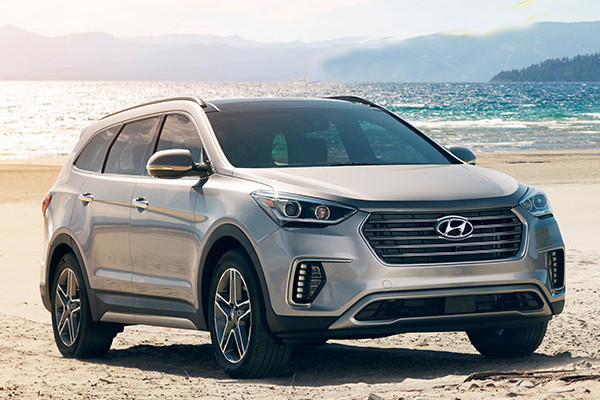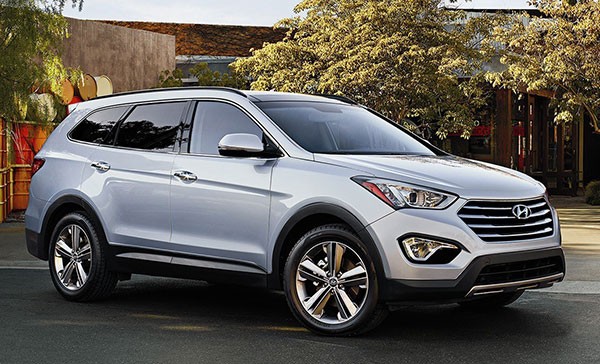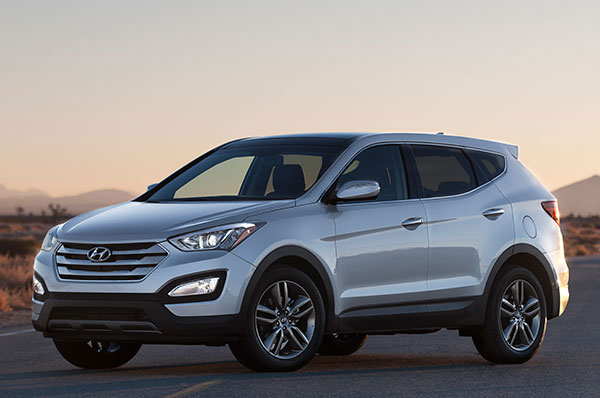

an account. You can:
Access your saved cars on any device.
Receive Price Alert emails when price changes,
new offers become available or a vehicle is sold.


Model Overview of The Hyundai Santa Fe's For Sale in Middletown, CT
2017 Hyundai Santa Fe Information
2017 Hyundai Santa Fe
Restyled for 2017, Hyundai Santa Fe looks sharper than before. The three-row Santa Fe features three rows of seating and is longer than the Santa Fe Sport. As in the past, Hyundai delivers good value with the sizable Santa Fe.
The 2017 Hyundai Santa Fe gets new bumpers, and the cabin has been upgraded a bit. A rearview camera has been made standard on all 2017 Santa Fe models. Also new is the 2017 Santa Fe Limited Ultimate trim level.
Two seating configurations are offered, split by trim level. Lower-cost Santa Fe SE and Santa Fe SE Ultimate trim levels contain a second-row bench, for seven-passenger seating. Stepping up toward opulence, Santa Fe Limited and Limited Ultimate editions get a six-passenger layout, making use of captains chairs in the second row. Cargo space excels with either passenger configuration, though space in the third row is limited, compared to that of its competitors.
All Hyundai Santa Fe models come with the same 3.3-liter V6 engine and 6-speed automatic transmission. The Dodge Durango and Honda Pilot use 8- or 9-speed transmissions, but the Santa Fes automatic is competent and capable. Developing 290 horsepower, the engine is shared with Hyundais Azera sedan, but retuned here to produce low-end torque more suitable for a crossover SUV.
Front-wheel drive and all-wheel drive are available, and the latter exacts only a slight penalty in terms of fuel economy. A Santa Fe weighs around two tons and can tow 5,000 pounds. Standard wheels are 18-inch, but Ultimate versions get 19-inch tires.
Viewed from the drivers seat, the dimensional advantage of the three-row Santa Fe over the smaller Santa Fe Sport crossover is clearly evident. Most Santa Fe versions have a power drivers seat. Heated front seating and a power passenger seat can be added as options.
The National Highway Traffic Safety Administration has not crash-tested the Santa Fe, though Hyundai anticipates a five-star overall score. In crash-testing by the Insurance Institute for Highway Safety, the 2017 Santa Fe earned mostly Good ratings, for both side-impact and moderate-overlap frontal collisions. The 2016 model suffered a troubling Marginal score on the small-overlap crash-test.
2016 Hyundai Santa Fe Information
2016 Hyundai Santa Fe
The Hyundai Santa Fe seven-passenger crossover SUV features a strong V6 engine, a comfortable ride and an abundant list of available features. The handsomely styled Santa Fe aims toward large families who can use the additional seating capacity, though passenger space in that third row is skimpy and best left to the little ones.
All-wheel drive is available for wintry weather traction; front-wheel drive is standard. The Santa Fe gets better fuel economy than might be expected of a V6 engine.
This third-generation Santa Fe was introduced for the 2013 model year as a three-row crossover, sharing some of its body structure with the smaller, five-passenger Santa Fe Sport. Not much else is shared between the two, and the Santa Fe Sport is powered by four-cylinder engines rather than a V6.
Participating in the three-row SUV category, Santa Fe competes against Ford Explorer, Toyota Highlander, Nissan Pathfinder, Honda Pilot, and Kia Sorento, that last one a cousin to the Santa Fe. Minivans are competitors, also.
Little has changed for the 2016 model year, except that the 2016 Hyundai Santa Fe SE is now the base model, formerly called GLS. Hyundais BlueLink telematics system remains standard. This OnStar-like system incorporates turn-by-turn navigation and Bluetooth streaming for apps such as Pandora, and works in conjunction with your smartphone.
The federal governments National Highway Traffic Safety Administration has not yet given the Santa Fe a crash-test rating. The Insurance Institute for Highway Safety gave Santa Fe a Marginal rating for small-overlap front-impact protection.
2014 Hyundai Santa Fe Information
2014 Hyundai Santa Fe
The Hyundai Santa Fe mid-size crossover utility was all-new for 2013, built on a new lighter-weight, higher-strength platform. The 2014 Hyundai Santa Fe comes in two handy family sizes: regular (long-wheelbase) and the smaller Sport.
The two-row, five-passenger Santa Fe Sport, about the same size as the previous-generation (2012) Santa Fe, competes in the fast-growing field of domestic and import compact crossovers that includes the Chevrolet Equinox, Ford Edge, Toyota RAV4, Honda CR-V.
The larger, three-row, six- or seven-passenger 2014 Santa Fe is 8.5 inches longer overall, on a 3.9-inch-longer wheelbase, to take on the Chevrolet Traverse, Ford Explorer, Toyota Highlander, Honda Pilot, and Mazda CX-9.
Both Santa Fes (and the smaller-yet Tucson) are crossover utility vehicles, or CUVs. That means they're car-based sport utilities, essentially tall wagons, which offer more car-like driving dynamics and fuel efficiency than truck-based SUVs.
Most revisions for 2014 apply to optional equipment. Blind Spot Detection is now available on all trim levels, while rear parking assistance is included in Technology Packages. HID (high-intensity-discharge) headlights and LED taillights are available for 2014 in the Santa Fe Sport 2.0T and Santa Fe Limited Technology Packages. New 18-inch wheels are standard on the Sport 2.0T. Rear side-window sunshades are part of the Santa Fe Sport Premium Package. Ventilated front seats with integrated memory are part of the Technology Packages. Also, 2014 Hyundai Santa Fe Sports equipped with a panoramic sunroof are now fitted with roof rails.
Two four-cylinder engine choices are available in the Santa Fe Sport: a 190-horsepower 2.4-liter non-turbo, and a turbocharged 264-hp 2.0-liter. The larger Santa Fe holds a 290-hp 3.3-liter V6. All three engines benefit from high-pressure gasoline direct injection (GDI) and drive through 6-speed automatic transmissions with SHIFTRONIC manual capability. All models offer available Active Cornering Control all-wheel drive.
EPA fuel economy ratings range from 20/27 mpg City/Highway for the base front-wheel-drive four-cylinder Santa Fe Sport, down to 18/24 mpg City/Highway for the 2.0T turbo Sport with all-wheel drive. That same 18/24 mpg estimate has been given to the larger Santa Fe with all-wheel drive. (Early Santa Fe Sports were rated as high as 21/29 mpg City/Highway, but Hyundai revised some fuel-economy estimates in late 2012.)
Hyundai's all-wheel drive continuously monitors driving conditions and enhances stability by managing brake and engine torque, vectoring one or the other toward or away from individual wheels to balance side-to-side and front-to rear traction. The result is improved cornering stability, reduced understeer (loss of front-wheel traction) or oversteer (loss of rear-wheel traction) to help the driver maintain control in tricky conditions. Standard Hillstart Assist Control minimizes roll-back on steep uphills, while Downhill Brake Control manages speed and enhances control on steep descents.
To our eyes, each Santa Fe is a handsome piece that's more distinctive than most of its compact CUV competitors. Styling follows Hyundai's recent fluidic sculpture design direction, though slightly toned down.
The 2014 Santa Fe's interior is modern and stylish, with an obvious focus on soft-touch materials and thoughtfully arranged, well-marked controls. The base Santa Fe Sport offers YES Essentials stain-resistant cloth seats, Hyundai Blue Link (similar to GM's OnStar) and a 40/20/40 split folding second-row seat. The Sport 2.0T and Santa Fe add more equipment.
The longer Santa Fe boasts 1.9 inches more second-row legroom and 5.6 cubic feet more total cargo capacity than the shorter Sport. Santa Fe comes with second-row climate controls and vents, and a 50/50 split folding third seat with 31.5 inches of legroom. The second row is a 40/20/40 split folding bench in GLS trim; twin Captain's chairs in the Limited.
We found our test Santa Fe Sport AWD 2.0T to be fully competitive and pleasant to drive. Performance was impressive when needed, the ride was smooth and controlled over most surfaces, braking was strong and stable, and handling was at least as good as most competitors.
2013 Hyundai Santa Fe Information
2013 Hyundai Santa Fe
The Hyundai Santa Fe mid-size crossover utility is all-new for 2013, built on a new lighter-weight, higher-strength platform. The 2013 Hyundai Santa Fe comes in two handy family sizes.
The two-row, five-passenger 2013 Santa Fe Sport, about the same size as the outgoing 2012 Santa Fe, competes in the fast-growing field of domestic and import compact crossovers that includes the Chevrolet Equinox, Ford Edge, Toyota RAV-4, Honda CR-V, and Nissan Murano.
The larger, three-row, six- or seven-passenger 2013 Santa Fe is 8.5 inches longer on a 3.9-inch-longer wheelbase to take on the Chevy Traverse, Ford Explorer, Toyota Highlander, Honda Pilot, and Mazda CX-9.
The compact Santa Fe Sport fits neatly between Hyundai's smaller Tucson and the larger Veracruz. The long-wheelbase (LWB) Santa Fe will replace the Veracruz. Santa Fe (and Tucson) are crossover utility vehicles, or CUVs, meaning they are car-based sport utilities, essentially tall wagons, which offer more car-like driving dynamics and fuel efficiency than truck-based SUVs.
Two engine choices are available in the Santa Fe Sport: a 190-hp 2.4-liter non-turbo inline-4 and a 264-hp 2.0-liter turbocharged four-cylinder. The LWB Santa Fe comes with a 290-hp 3.3-liter V6. All three engines benefit from high-pressure gasoline direct injection (GDI) and drive through 6-speed automatic transmissions with SHIFTRONIC manual capability, and all models offer available Active Cornering Control (ACC) all-wheel drive.
EPA fuel economy ratings range from 22 City, 33 Highway, 26 Combined for the base front-wheel-drive four-cylinder Santa Fe Sport to 19/26/22 mpg for the LWB FWD Santa Fe with its V6.
Hyundai's ACC all-wheel drive continuously monitors driving conditions and enhances stability by managing brake and engine torque and vectoring one or the other toward or away from individual wheels to balance side-to-side and front-to rear traction. The result is improved cornering stability, reduced understeer (loss of front-wheel traction) or oversteer (loss of rear-wheel traction) to help the driver maintain control in tricky conditions. Standard Hillstart Assist Control (HAC) minimizes roll-back on steep uphills, while Downhill Brake Control (DBC) manages speed and enhances control on steep descents.
To our eyes, this new Santa Fe is a handsome piece that's more distinctive than most of its compact CUV competitors. Its styling follows Hyundai's recent fluidic sculpture design direction, though slightly toned down from the level of boldness that has helped lift the company's Sonata to a major player in the super-competitive mid-size sedan segment.
The 2013 Santa Fe's new interior is modern and stylish, with an obvious focus on soft-touch materials and thoughtfully arranged, well-marked controls. The base Santa Fe Sport offers YES Essentials stain-resistant cloth seats, a trip computer, Hyundai Blue Link (similar to GM's OnStar) safety and convenience connectivity and a 40/20/40 split folding second-row seat to accommodate skis, golf clubs or surfboards along with one or two rear passengers. The Sport 2.0T and Santa Fe add more equipment, and a plethora of comfort, convenience and communications features, some exclusive, are available.
The longer Santa Fe boasts 1.9 inches more second-row legroom and 5.6 cubic feet more total cargo capacity than the shorter Sport does. Santa Fe comes with second-row climate controls and vents and a 50/50 split folding third seat with 31.5 inches of legroom. The second row is the 40/20/40 split folding bench in the GLS trim, twin Captain's chairs in the Limited.
The new, lighter structure is built with 37.7 percent high-strength steel, part of the reason the base Sport model is some 266 pounds lighter than the outgoing 2012 Santa Fe and the LWB Santa Fe nearly 400 pounds lighter than the Veracruz it will replace. This also makes it stiffer, which enhances both ride and handling for driving enjoyment, and better manages crash energy should something bad happen. The suspension is lightweight MacPherson struts in front, independent multi-link in back, with stabilizer bars at both ends.
We found our test Santa Fe Sport AWD 2.0T fully competitive and pleasant to drive. Its performance was impressive when needed, its ride was smooth and controlled over most surfaces, its braking was strong and stable, and its handling was at least as good as most competitors in its class. Aside from a few minor niggles, our only disappointment was averaging 21-22 mpg in mostly freeway driving, well short of its 27-mpg highway government rating.



